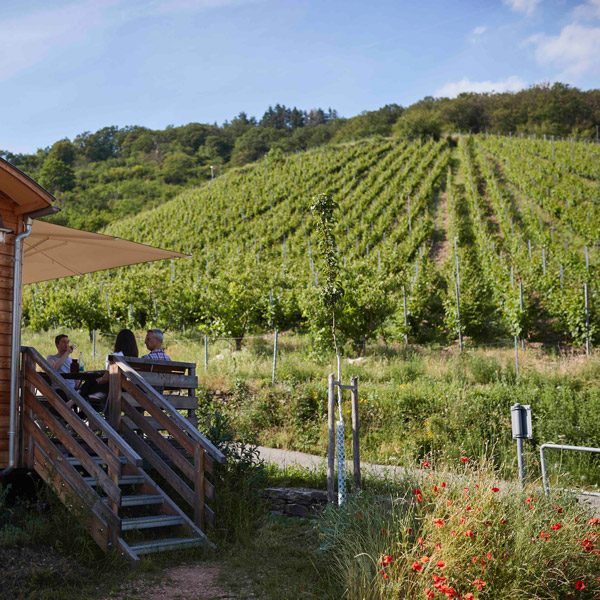 The buzzword "nudging" is currently one of the big trends among marketing professionals. Jon Hanf, Professor of International Marketing Management at Geisenheim University, explains what it means, how wineries can use it and what role tourism plays in this.
The buzzword "nudging" is currently one of the big trends among marketing professionals. Jon Hanf, Professor of International Marketing Management at Geisenheim University, explains what it means, how wineries can use it and what role tourism plays in this.We are constantly influenced: do this, buy that, if you order that, it will make you happy. We don't always notice the small incentives - or we get so used to them that the stimulus threshold gets higher and higher. In recent years, the term "nudging", which originated in behavioural economics, has found its way into marketing and consumer research. Nudging is a method of influencing people's behaviour without commandments or prohibitions, but with incentives. In this way, unconscious actions are encouraged without the addressee being aware that he is being directed. Two examples are the placement of healthy food and fruit at eye level to increase their consumption - or the image of a fly stuck in urinals to better "target" and thus reduce the need for cleaning.
Professor Jon Hanf of the Geisenheim University of Applied Sciences has studied nudging intensively. Anyone hoping for instructions on how to sell more wine, for example, will be disappointed, but should read on anyway. Because the most important thing that traders and winegrowers can do is classic marketing, explains Hanf. Even at that, they very consciously tried to motivate consumers to take desired actions. "It's just a new packaging, because this form of influencing behaviour has always existed. The fact that you ask me about it shows that the new buzzword works," Jon Hanf says and laughs.
In the private sector, there would be fewer opportunities for nudging. This is more the preserve of actors and stakeholders, for example in economic policy, to minimise - or build up - subliminal barriers, he says.

"Consumers tend to buy things that don't reflect their real preferences, but are made out of convenience or habit. There's a lot of that going on with food," he says, explaining the limitations. But the concept also works in the opposite direction: nudging is also used to reduce alcohol consumption. "We will probably soon have to deal with more difficult access to alcohol," predicts Hanf, "it will still exist. But the bottles will in the future be placed in the shops in such a way that you have to look for them first. Instead, non-alcoholic drinks will be placed directly in the field of vision, so that more people will reach for them spontaneously. The customers don't even notice that they are being guided, but they may think about buying alcohol more consciously than before. That's how classic nudging works."
In general, governments in very many countries around the world are trying to make access to and consumption of alcoholic beverages more restrictive. Jon Hanf would prefer clear regulations: "The industry can adapt to that. A clear economic policy requirement is easier to discuss than something that comes along indirectly and unconsciously. If the economic policy actors work with well-set nudges with which incentives are controlled accordingly, I can react less well to it."
Accordingly, it is currently enormously important for winemakers to know their customers, their wishes and their needs. "This way I can set targeted stimuli and thus influence the behaviour of my customers. Of course, this must not come across as paternalism. The more pleasing I appear to him, the more willing he will be to make the purchase. Today, through social media, I can get data and feedback much faster than ever before. I can adjust it and set real nudges with it."
But there is also another chance to get to know your customers: by personally attending to them at the winery. This can be at a wine tasting or in the Straußwirtschaft. "As soon as the customer is with me at the farm, I can make an effort to put him in a pleasant situation, for example with tasting, hospitality and good conversation. He should not even have the chance to leave my farm without buying wine. But this must never seem rehearsed or placative for him."
Wine tourism is a good opportunity to respond to customers' wishes. "But one must not forget that wine is always only one element of cultural, leisure and event tourism. Hardly anyone goes to a wine-growing region to visit five wineries a day and taste them permanently. Most people want to hike, cycle, consume culture, attend an event and eat well. Wine is a part of this whole programme. That's why I prefer to speak of tourism with wine rather than wine tourism," Hanf emphasises.
For him, even a visit to a Buschenschank or Straußwirtschaft in the evening or at the weekend is a form of tourism. For winegrowers, this kind of customer loyalty is at the same time the optimal market research: they can study the customers' ordering behaviour in an informal atmosphere, present them with news and even experiments and record changes in the customers' demands. Hanf: "I know many great winegrowers who would never use the word marketing. But they know exactly what makes their customers tick, how to fry the schnitzel properly and how to present their wines. That's basically excellent marketing, they pick up their customers. They can control sales with that."

One should not forget that the direct sales of wineries have dropped considerably in the meantime. Many young winegrowers, however, want to concentrate more on making wine at the moment. They are sceptical about being pub operators. On the other hand, many wineries have become bigger, have opened up new distribution channels and thus new customers. "What the old simply had in their heads, the young have to systematically determine. But: they have the end-customer contacts, they have the possibility to generate and utilise data and to influence their customers' preferences in such a way that they profit from it as a winery. Whether you call it marketing or nudging is ultimately irrelevant," John Hanf sums up and adds: "No winemaker would say that he is guided by customer wishes. Nevertheless, the successful ones try to work on the perception of their products and to be more responsive to the customers' wishes. If I do that as a winemaker, I can suddenly advise again. If I only try to sell my products, I quickly get stuck. Individual counselling opens up for me how customers feel, how and what they consume more of and why they come back. The salesperson must see himself as a problem solver: What does the customer want: entertainment? Advice? Or does he want to be left alone? As a winemaker, I have to respond to everyone individually - and satisfy their needs."
Photo: © DWI, Jon Hanf